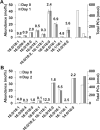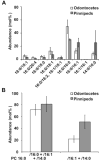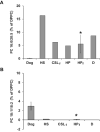Phosphatidylcholine composition of pulmonary surfactant from terrestrial and marine diving mammals
- PMID: 25812797
- PMCID: PMC4450144
- DOI: 10.1016/j.resp.2015.02.004
Phosphatidylcholine composition of pulmonary surfactant from terrestrial and marine diving mammals
Abstract
Marine mammals are repeatedly exposed to elevated extra-thoracic pressure and alveolar collapse during diving and readily experience alveolar expansion upon inhalation - a unique capability as compared to terrestrial mammals. How marine mammal lungs overcome the challenges of frequent alveolar collapse and recruitment remains unknown. Recent studies indicate that pinniped lung surfactant has more anti-adhesive components compared to terrestrial mammals, which would aid in alveolar opening. However, pulmonary surfactant composition has not yet been investigated in odontocetes, whose physiology and diving behavior differ from pinnipeds. The aim of this study was to investigate the phosphatidylcholine (PC) composition of lung surfactants from various marine mammals and compare these to a terrestrial mammal. We found an increase in anti-adhesive PC species in harp seal (Pagophilus groenlandicus) and California sea lion (Zalophus californianus) compared to dog (Canus lupus familiaris), as well as an increase in the fluidizing PCs 16:0/14:0 and 16:0/16:1 in pinnipeds compared to odontocetes. The harbor porpoise (a representative of the odontocetes) did not have higher levels of fluidizing PCs compared to dog. Our preliminary results support previous findings that pinnipeds may have adapted unique surfactant compositions that allow them to dive at high pressures for extended periods without adverse effects. Future studies will need to investigate the differences in other surfactant components to fully assess the surfactant composition in odontocetes.
Copyright © 2015 Elsevier B.V. All rights reserved.
Figures







Similar articles
-
Surfactant from diving aquatic mammals.J Appl Physiol (1985). 2004 May;96(5):1626-32. doi: 10.1152/japplphysiol.00898.2003. Epub 2003 Dec 19. J Appl Physiol (1985). 2004. PMID: 14688033
-
The development of the pulmonary surfactant system in California sea lions.Comp Biochem Physiol A Mol Integr Physiol. 2005 Jun;141(2):191-9. doi: 10.1016/j.cbpb.2005.05.035. Comp Biochem Physiol A Mol Integr Physiol. 2005. PMID: 15964230
-
Control of pulmonary surfactant secretion in adult California sea lions.Biochem Biophys Res Commun. 2004 Jan 16;313(3):727-32. doi: 10.1016/j.bbrc.2003.12.012. Biochem Biophys Res Commun. 2004. PMID: 14697251
-
The evolution of a physiological system: the pulmonary surfactant system in diving mammals.Respir Physiol Neurobiol. 2006 Nov;154(1-2):118-38. doi: 10.1016/j.resp.2006.04.012. Epub 2006 Apr 28. Respir Physiol Neurobiol. 2006. PMID: 16877052 Review.
-
Metabolic status during diving and recovery in marine mammals.Int Rev Physiol. 1979;20:253-87. Int Rev Physiol. 1979. PMID: 387635 Review. No abstract available.
Cited by
-
Cardiorespiratory adaptations in small cetaceans and marine mammals.Exp Physiol. 2024 Mar;109(3):324-334. doi: 10.1113/EP091095. Epub 2023 Nov 15. Exp Physiol. 2024. PMID: 37968859 Free PMC article. Review.
-
Lipid profiling suggests species specificity and minimal seasonal variation in Pacific Green and Hawksbill Turtle plasma.PLoS One. 2021 Jul 19;16(7):e0253916. doi: 10.1371/journal.pone.0253916. eCollection 2021. PLoS One. 2021. PMID: 34280208 Free PMC article.
-
Streptococcal Infections in Marine Mammals.Microorganisms. 2021 Feb 10;9(2):350. doi: 10.3390/microorganisms9020350. Microorganisms. 2021. PMID: 33578962 Free PMC article. Review.
-
Evolutionary genetics of pulmonary anatomical adaptations in deep-diving cetaceans.BMC Genomics. 2024 Apr 4;25(1):339. doi: 10.1186/s12864-024-10263-9. BMC Genomics. 2024. PMID: 38575860 Free PMC article.
-
Surfactant protein SP-B: one ring to rule the molecular and biophysical mechanisms of the pulmonary surfactant system.Biophys Rev. 2025 Mar 18;17(2):653-666. doi: 10.1007/s12551-025-01285-y. eCollection 2025 Apr. Biophys Rev. 2025. PMID: 40376411 Review.
References
-
- Bernhard W, Hoffmann S, Dombrowsky H, Rau GA, Kamlage A, Kappler M, Haitsma JJ, Freihorst J, von der Hardt H, Poets CF. Phosphatidylcholine molecular species in lung surfactant: composition in relation to respiratory rate and lung development. Am J Respir Cell Mol Biol. 2001;25:725–731. doi: 10.1165/ajrcmb.25.6.4616. - DOI - PubMed
-
- Bernhard W, Raith M, Pynn CJ, Gille C, Stichtenoth G, Stoll D, Schleicher E, Poets CF. Increased palmitoyl-myristoyl-phosphatidylcholine in neonatal rat surfactant is lung specific and correlates with oral myristic acid supply. J Appl Physiol. 2011;111:449–457. doi: 10.1152/japplphysiol.00766.2010. - DOI - PubMed
-
- Bramble DM, Jenkins FA. Mammalian locomotor-respiratory integration: implications for diaphragmatic and pulmonary design. Science. 1993;262:235–240. - PubMed
Publication types
MeSH terms
Substances
Grants and funding
LinkOut - more resources
Full Text Sources
Other Literature Sources

